On a fine weekend evening, locals gather at the harbour in Watchet, west Somerset. Town crier David Milton, dressed in a gilt-trimmed green jacket and tricorn hat, leads the singing: lusty accounts of drunken and lovelorn sailors and maritime glories past. Kids bob on parents’ shoulders and seagulls cast figures-of-eight against the blue-grey horizons of the Bristol Channel, and soft outlines of Wales’s Barry island beyond.
Rather than a nod to the pandemic’s TikTok fad, Watchet’s monthly shanty singalongs are an expression of a proud maritime identity for a town that’s often overlooked by the craft cider suppliers and luxury country cottage-bookers on the West Country holiday circuit.

A few steps east along the harbourfront, a new symbol of Watchet’s pride rises against the coastal blues: a cubist jungle of brightly coloured boxes overlooking the dry dock. Designed by Invisible Studio architect Piers Taylor and realised by a determined collective of local women, East Quay is a £6.3m cultural venue with a gallery, restaurant, studios and rooms, all funded, in part, by the Coastal Communities fund and Arts Council England. It proposes a model for how tourism can be put to work for good in our struggling coastal communities.
Edwardian guidebook writer Mrs Osborne Hann said of Watchet that it was “more like a foreign quay than any place I know of … a quaint and higgledy-piggledy town [where] houses seem to have dropped willy-nilly from the skies”.
“It hasn’t much changed,” smiles Georgie Grant, one of the co-directors of project founders the Onion Collective (or “Onions” as the five-woman team call themselves). “Watchet has a character all its own,” she says, as she takes me on a tour of the town’s High Street, with its 16th-century inns and sloping, ice-cream-coloured facades.
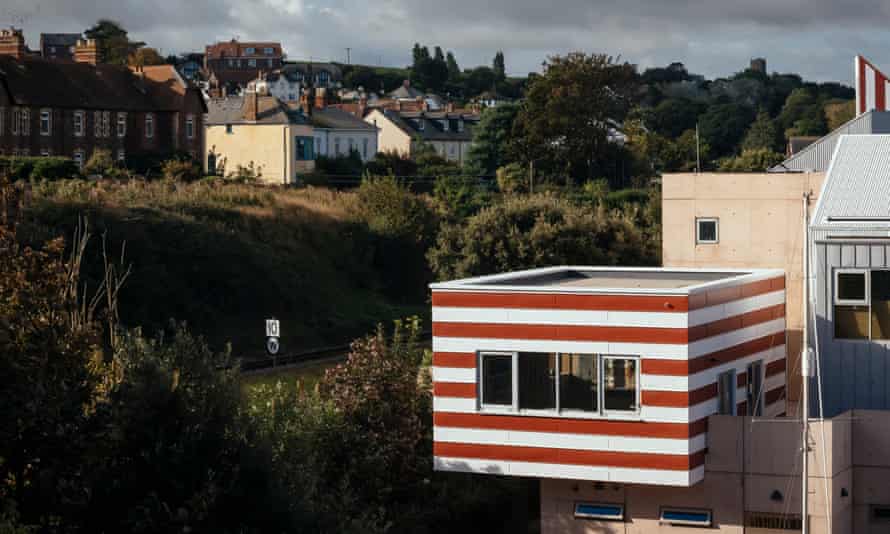
Despite this civic spirit, Watchet was in a rough place in the mid 2010s, when its largest employer, a paper mill dating back to the mid-17th century and known locally as “the family”, shut its doors for good. In 2013, when plans fell through for a controversial development of luxury flats on the marina quayside, Georgie and her fellow Onions – Jess Prendergrast, Rachel Kelly, Sally Lowndes and Naomi Griffith – decided to pool their skills in local politics, charity and arts management and ask fellow Watchet residents what they wanted for their town. Many Watcheters, Georgie recalls, were keen to restore the town’s Boat Museum, dedicated to the traditional boats – known as “flatties” – that used to sail the shallow mudflats at low tide; others wanted to perk up the visitor centre to attract more outsiders to a town that lures 70,000 tourists a year (compared with the million that decant in nearby Minehead). Most of these arrive as daytrippers on the heritage West Somerset railway which puffs the 20-mile route to Watchet from Minehead four times a day in summer (and for festive fish-and-chip and steam-and-cream themed itineraries in colder months).
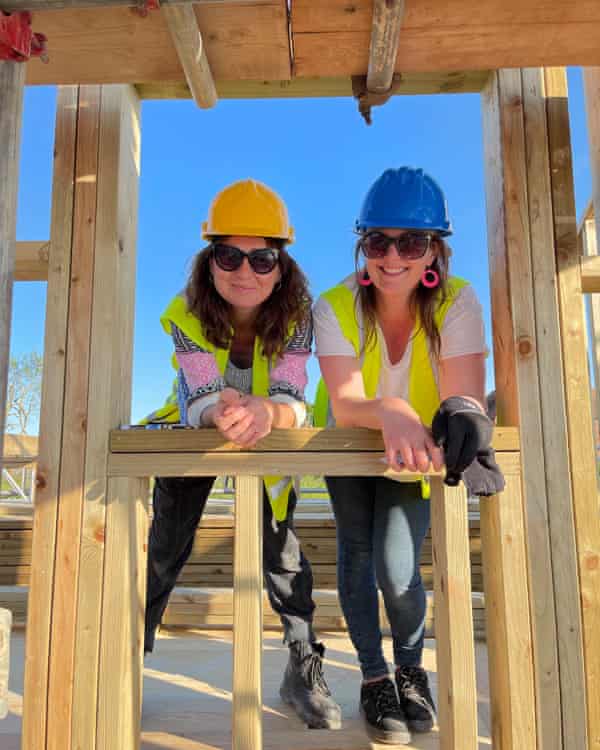
“We just listened to the locals,” says Georgie. “And eight years down the line, with some sweat and tears, Watchet has its Boat Museum, its visitors’ centre and this” – she gestures around the East Quay site from the courtyard that will also serve as a theatre performance space.
Opened in October and commanding a third of Watchet’s harbour front, East Quay features a double-storey immersive art gallery run by arts charity Contains Art; 14 studio/workshops for local artists; a geology and ecology workshop; an alternative education space designed by local schoolchildren; a bistro and five self-catering accommodation pods, with interiors designed by Hereforshire maker-architects Pearce+Fægen (available to book from early 2022).
Crucially, in an area with England’s lowest social mobility and an average household income of £16,000 a year, East Quay delivers 37 decent new jobs, including five apprenticeships, and it will support 109 jobs indirectly from visitors’ spending on local businesses.
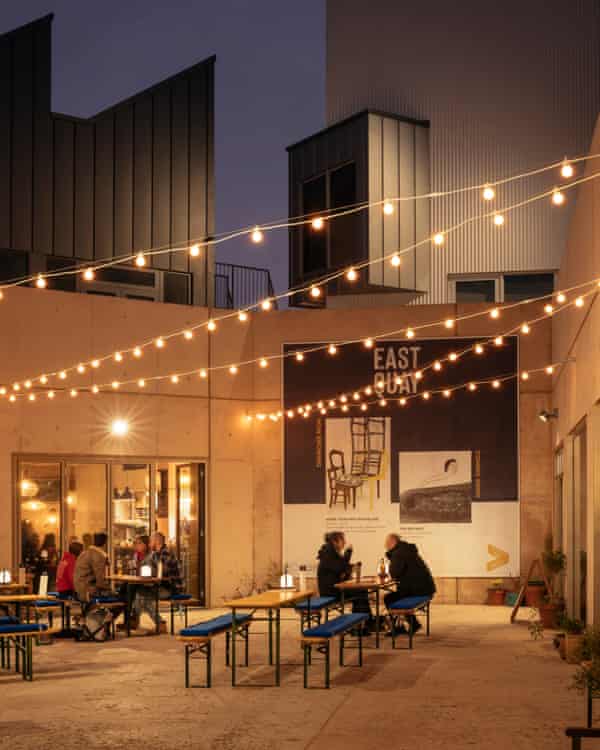
The five pods (which sleep between two and four) are multi-level metal boxes inspired by Watchet’s industrial and maritime history with, as Jess puts it, “a bit of graffiti and steampunk thrown in”. Each pod is individually themed – Playful Architecture, for example, has adaptive furniture (chairs that transform into tables and chaise longues) and a cargo net to kip in, and Industrial Heritage features a ship’s ladder and a bespoke iron bathtub with a view. The pods are tucked between artists’ studios, to encourage visitors to pop in for a cuppa and check out the artists’ collaborative productions.
With brilliant light glancing off the Bristol Channel and the harbour fringed by moored boats, Pod One, Object Exchange, feels a bit like being a guest on a luxury yacht. As in the other pods, there’s a ground-floor bathroom and a kitchen with hob, microwave and grill, kettle, fridge and toaster. On a mezzanine level, a two-seat sea viewing platform has floor-to-ceiling glass offering 180-degree waterfront views.
A “lost and found” feature arranged across its floor-to-ceiling shelves, lets visitors leave behind something that reminds them of their trip as they pick up a souvenir: maybe a piece of handmade paper or a fossil mudlarked from the coastline, where Jurassic and Triassic sediments meet in riot of striated limestone and ochre. In keeping with East Quay’s stance on supporting local labour markets, the pods’ bedding is made by a Devonshire company that stitches mattresses by hand, and packs of seasonal local produce greet arrivals, while freshly baked bread is on offer each morning from the on-site bistro, East Quay Kitchen, delivered to your door on request.
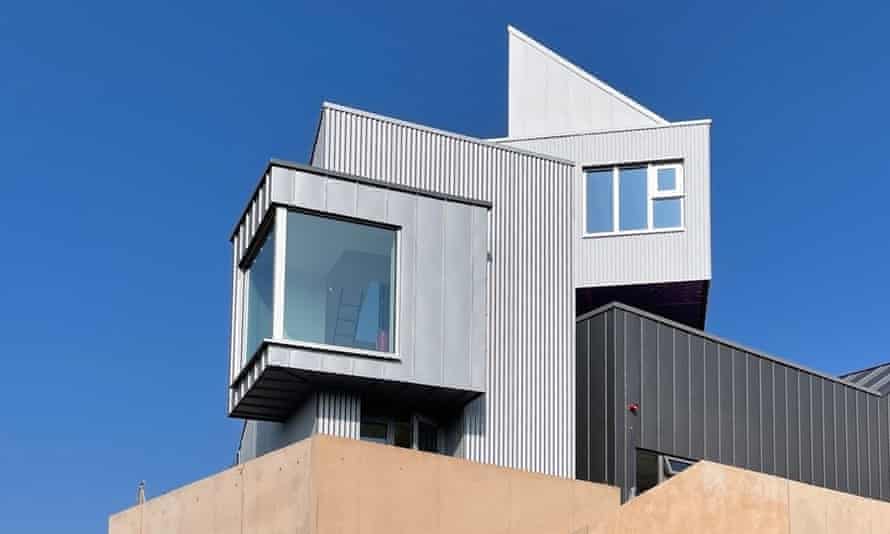
At the heart of the ground-floor level of East Quay there’s another nod to Watchet’s heritage: a working paper mill. Local papermaker Jim Patterson was an apprentice at Wansbrough Paper Mill in the early 1970s, before setting up his own specialist watercolour paper factory, Two Rivers Paper in 1976. The 74-year-old was planning to retire, but has been lured back into artisan papermaking to train a new generation at East Quay. “Watching Jim at work will be a highlight for visitors,” Georgie says. From late 2022, East Quay will also be home to a factory that produces living construction materials from the mycelium fungus, a cutting-edge post-carbon technology.
East Quay follows a wave of social enterprises that channel tourist revenue into local community renewal. They include Foxes Hotel in Minehead, which offers apprenticeships to young people with disabilities, and London’s Good Hotel, which trains long-term unemployed Londoners. In an era in which many locals in popular coastal spots rail against overtourism, there’s also a win-win, Jess believes, in spreading footfall to under-visited destinations. “We want to widen the holiday season here to reduce job seasonality,” she says, “and we’re providing new accommodation pods, rather than seeing local property converted to holiday lets, or sold as second homes.”
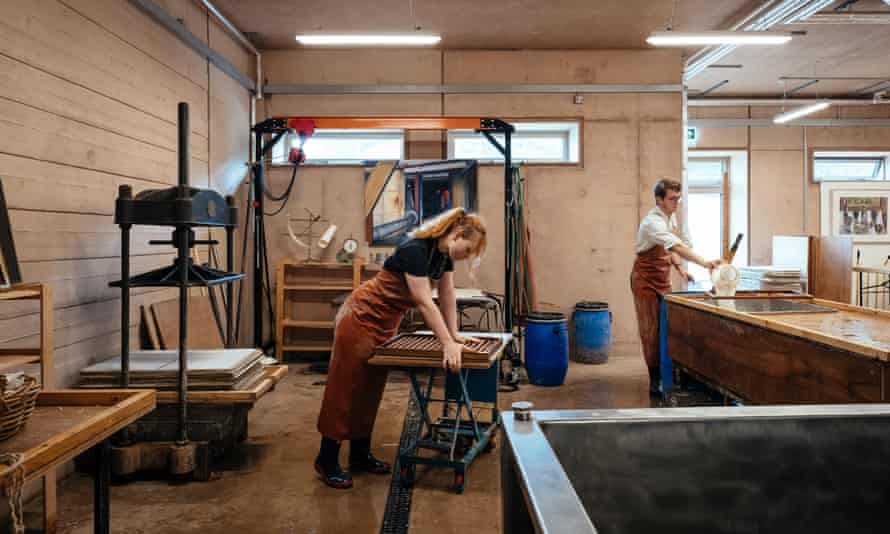
As the afternoon sun gilds the sea, I climb with Jess and Georgie to one of two viewing platforms above the site, where locals and visitors will be able to come for views over old and new Watchet, and the hubbub of East Quay below. The development has already encouraged new marina owners the Marine Group to dredge Watchet’s silted-up dry dock; the Onions hope that leisure boat moorings will increase and that one day the pleasure ferries that used to ply the route from Watchet to the Welsh coast in the 1950s and 60s will return.
We walk up the harbourside from East Quay as a steam train wheezes into the station. As we climb the bridge over the rail tracks, a teenager in a logo sweatshirt stops and stares at Jess. “Are you one of them Onion women who’s doing East Quay?” he enquires. Jess nods, uncertainly. The teenager pumps his fist in the air. “Big up the Onion Collective!” he cries.
East Quay’s pods cost from £100 a night, eastquaywatchet.co.uk
Tourism social enterprises across the UK
Jubilee Pool, Penzance
One of Europe’s last remaining seawater lidos, Jubilee was threatened with closure following storm damage, but in 2017 was taken over by a community benefit society. The group has restored the pool to its art deco glory and runs the pool – now a major tourist attraction – for the community.
South Tynedale Railway, Cumbria
Volunteers at South Tynedale Railway Preservation Society have created a tourist attraction straddling two of the UK’s most deprived rural areas: a narrow-gauge railway winding from Alston through the picturesque South Tyne Valley. It attracts hundreds of thousands of visitors a year.
Art B&B, Blackpool
This classic Victorian seafront hotel, renovated by 30 contemporary artists, reinvests its profits in local arts and community projects and stages events, talks and workshops for locals.
Good Hotel, London
Set on a boat in London’s Docklands, the Good Hotel provides jobs and career training for long-term unemployed Londoners. Profits from the project go to educate children through the hotel’s global foundation, including in Guatemala, where the original Good Hotel was founded in 2007.
Bristol Ferry Boats
Bristol harbour’s iconic yellow-and-blue boat fleet has been run for community benefit since 2013, with the group who run the boats staging interactive tours, wildlife spotting and storytelling trips for Bristolians.
Tower House, Oxford
This guesthouse supports the charity Student Hubs, which helps the city’s students tackle local social challenges and works to keep students from less-privileged backgrounds in the higher education system.




